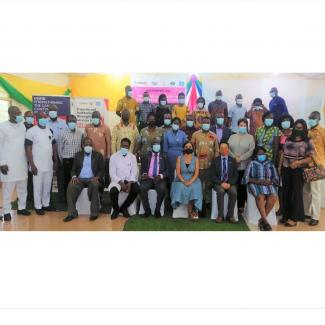background
Prior to fiscal year (FY) 2020, Ghana was a bilateral President’s Emergency Plan for AIDS Relief (PEPFAR) program. Starting in Regional Operational Plan (ROP)19, Ghana joined the West Africa Regional program, which includes eight countries. Before joining the Regional Program, Ghana’s HIV program was a nationwide key populations (KP) program focused on female sex workers (FSW) and men who have sex with men (MSM). Then, it shifted to supporting direct service delivery models to achieve epidemic control in one focused region, Western Region, and subsequently expanded into the Western North and Ahafo Regions due to the program’s demonstrated successes. The overall objective of the PEPFAR/Ghana program is to demonstrate that achieving epidemic control in Ghana is possible, and to work with the Government of Ghana to scale up successful interventions nationwide.
AT A GLANCE
In 2003, the United States President’s Emergency Plan for AIDS Relief (PEPFAR) was launched to address HIV/AIDS globally. Through PEPFAR, the U.S. government has invested nearly $100 billion in the global HIV/AIDS response, the largest commitment by any nation to address a single disease in history, saving 21 million lives, preventing millions of HIV infections, and accelerating progress toward controlling the global HIV/AIDS epidemic in more than 50 countries.
GHANA HIV CONTEXT
Ghana’s epidemic is characterized as being mixed, meaning that key populations, other vulnerable populations, and the general population all make up significant portions of the persons living with HIV (PLHIV). In Ghana, the number of PLHIV is estimated at 347,370 (Spectrum 2021), with an adult prevalence rate of 1.67% (Spectrum 2021). Estimates among MSM are 18.1% (GMS II, 2017) and 4.6% among FSW (IBBSS, 2019). Approximately 63% of PLHIV know their status (UNAIDS (2020), 73% of PLHIV are on antiretroviral therapy (ART), and 79% of PLHIV are virally suppressed (Spectrum 2021).
HIV IMPLEMENTATION
PEPFAR Ghana supports achieving epidemic control at both national, regional, and site levels. USAID’s primary activities are focused on service delivery, in three (3) focused regions, including Western, Western North, and Ahafo. The U.S Center for Disease Control and Prevention (CDC) provides national-level support to the Ghana AIDS Commission (GAC) and the Ghana Health Service’s National AIDS Control Program (NACP) for strengthening Ghana’s strategic information, laboratory systems and viral load chain sample referrals. The Department of Defense (DOD) supports the Ghana Armed Forces to address service delivery needs among Ghana’s military forces, and; the Department of State works to train journalists to more accurately report on HIV/AIDS.

